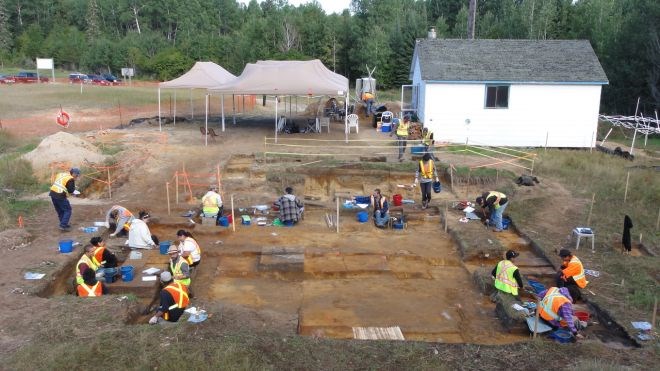Many large-scale development projects in the Province of Ontario require an archaeological assessment prior to any major work being done.
But, as archaeologist Luke Dalla Bona notes, if all parties work together, the assessment shouldn’t be seen as a threat to development.
Regulated by the provincial government, the archaeological assessment process is laid out in clear, concise terms that make it easy to navigate — and the sooner the better.
“Those people who successfully get through the archaeological process are the ones who started early in their development process and are willing to engage in it honestly,” Dalla Bona said. “They're the ones that sail through the process quite easily.”
Dalla Bona is a principal at Woodland Heritage, an archaeological consulting firm he and his partner, Dr. John Pollock, formed in 1999.
With offices in Sault Ste. Marie and New Liskeard, Woodland Heritage undertakes archaeological consultation on developments ranging from mines to hydroelectric dams to cottage lots to renewable energy projects.
Ninety per cent of their commissions take place in Northern Ontario; their work has taken them from the Manitoba border to the shores of Lake Erie and up to Hudson Bay.
According to the province, archaeological assessments are triggered by housing subdivisions and other land development projects; public development projects; quarrying, forest harvesting, pipeline installations and other land use activities; and when development is proposed for provincially owned lands.
Archaeologists follow a four-stage assessment protocol, which proceeds as new evidence of cultural heritage emerges at a site.
In the initial phase, the land is evaluated and any findings are submitted to the province. If there is potential for it to be an archaeological site, the process moves to Stage 2.
At this stage, archaeologists undertake a field assessment to try to verify what was found in the report.
“That involves digging the test pits and putting the soil through a screen, and if you find something, then you have verified the existence of a site,” Dalla Bona said.
In Northern Ontario, cultural heritage artifacts could include arrowheads, spear points, ceramic pottery, or shards of stone dating as far back 11,000 years to pre-contact Indigenous history, he noted. But it could also include sites associated with the construction of the railroads, fur trade posts, POW camps, or early logging camps.
“These are wonderful little time capsules of very particular activity and an important part of Ontario’s history,” Dalla Bona said.
If a site has been verified, the process moves to Stage 3, which is more time and labour intensive and can often require teams of 20 or 25 people to excavate pits and do more testing. If the site is deemed to be important, it moves to Stage 4.
This is when a full-blown excavation gets underway, and the archaeological team is tasked with moving the resource in a scientific way before it gets destroyed in an unscientific way, Dalla Bona said.
A Stage 1 archaeological assessment may just need one or two people at the site for a few days, whereas a site that has reached Stage 4 could require months of intensive, daily examination and dozens of people to complete the work.
“It all depends on how big the site is, how important the site is, and what the development pressure is,” Dalla Bona said.
At all times, the archaeologists work on behalf of the resource, even if it means delivering bad news to the developers who hire them.
But in most cases, Dalla Bona said the government and the developer will work together to find a solution that suits all parties. That may mean the developer leaves part of his project undeveloped, in order to avoid the cultural resource.
“The archaeological site has been in the ground for thousands of years,” he said. “Leaving it there longer is not going to hurt it anymore.”
In the mid-2000s, Woodland Heritage was hired by Ontario Power Generation (OPG), which wanted to make some upgrades to one of its hydroelectric projects, located between Timmins and Gogama. OPG wanted the firm to take the time and care required to conduct a smooth archaeological consultation process.
From the outset, Woodland worked in partnership with the local First Nation, holding a series of meetings and building a strong relationship with the community.
When it came time for the excavation, Woodland found a significant site — uncovering both Indigenous and OPG artifacts — at the exact location where OPG wanted to expand its dam. But because of the trust built between the archaeological firm, OPG and the community, the project was a success.
“In the end, the project was done on time, with no delays, and the archaeology actually came in under an average budget for a project of that size,” Dalla Bona said. “Respectful engagement with the different stakeholders doesn’t cost more, doesn’t necessarily take more time, and in the end, the work still gets done and everybody leaves feeling happy about it.”
Over the years, archaeologists have introduced a number of new innovations to aid in the assessment work — aerial photography, satellite imagery, electromagnetic resistivity, ground-penetrating radar, and even drones, the trendiest of modern gadgets — to make new discoveries.
But, Dalla Bona said, even the fanciest of technologies can’t replace the knowledge, experience and resourcefulness of a seasoned archaeologist.
“They do help us understand what the landscape is like and what might be under the ground,” he said. “But nothing will ever replace the need to dig a hole and see what’s actually in the soil.”




